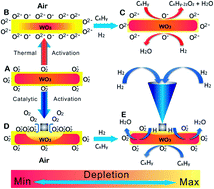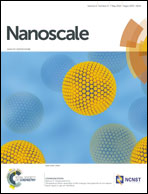Strongly coupled hybrid nanostructures for selective hydrogen detection – understanding the role of noble metals in reducing cross-sensitivity†
Abstract
Noble metal–semiconductor hybrid nanostructures can offer outperformance to gas sensors in terms of sensitivity and selectivity. In this work, a catalytically activated (CA) hydrogen sensor is realized based on strongly coupled Pt/Pd–WO3 hybrid nanostructures constructed by a galvanic replacement participated solvothermal procedure. The room-temperature operation and high selectivity distinguish this sensor from the traditional ones. It is capable of detecting dozens of parts per million (ppm) hydrogen in the presence of thousands of ppm methane gas. An insight into the role of noble metals in reducing cross-sensitivity is provided by comparing the sensing properties of this sensor with a traditional thermally activated (TA) one made from the same pristine WO3. Based on both experimental and density functional theory (DFT) calculation results, the cross-sensitivity of the TA sensor is found to have a strong dependence on the highest occupied molecular orbital (HOMO) level of the hydrocarbon molecules. The high selectivity of the CA sensor comes from the reduced impact of gas frontier orbitals on the charge transfer process by the nano-scaled metal–semiconductor (MS) interface. The methodology demonstrated in this work indicates that rational design of MS hybrid nanostructures can be a promising strategy for highly selective gas sensing applications.


 Please wait while we load your content...
Please wait while we load your content...